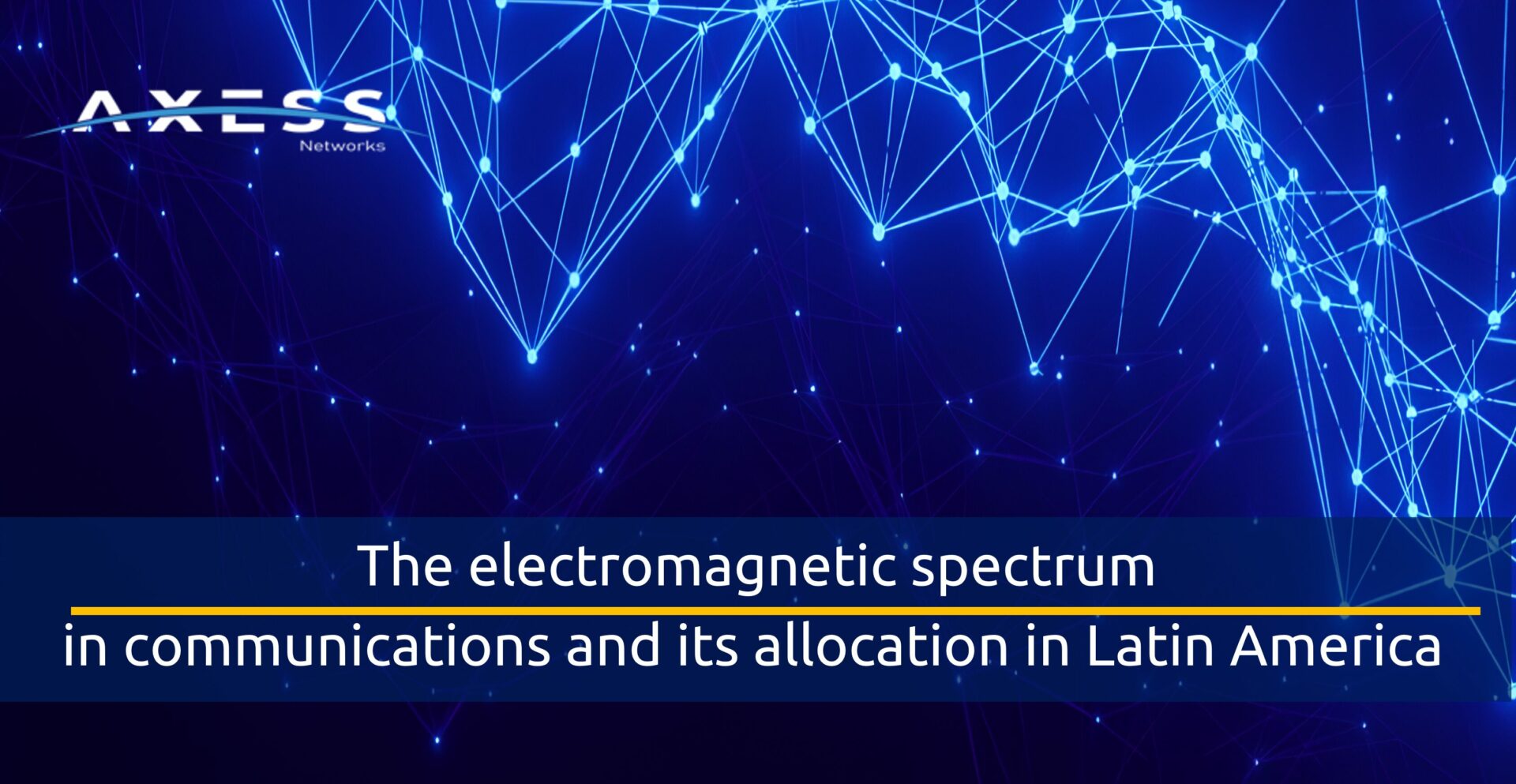
MINTIC, AXESS Networks and Hispasat deliver tele-education solutions with satellite internet to strengthen schools in Riosucio and Puerto Colombia
8 September, 2023
Proxy server to protect internet privacy
12 February, 2024The electromagnetic spectrum in communications and its allocation in Latin America

The electromagnetic spectrum refers to the full range of all possible frequencies of electromagnetic radiation. Electromagnetic radiation is a form of energy that spreads through space in the form of electromagnetic waves. These waves can vary in wavelength and frequency, and are organized into a spectrum that ranges from the low-frequency radio waves to high-frequency gamma rays. The electromagnetic spectrum is distributed in ascending order of frequency and energy as follows:
Radio waves: These have the lowest frequency within the electromagnetic spectrum and are used in radio broadcasting, wireless communications, and other applications.
Microwaves: These are used in wireless communication technology, microwave ovens, and in some radar applications.
Infrared: This region of the spectrum is divided into near infrared, mid-infrared, and far-infrared. It is used in applications such as night vision, fiber optics communications and infrared heating.
Visible light: This is the part of the electromagnetic spectrum that we can perceive with our eyes. It includes all wavelengths ranging from violet through red color.
Ultraviolet: Ultraviolet (UV) radiation is responsible for causing sunburn and it is used in applications such as sterilization and photolithography.
X-rays: the X-rays have the capacity to pass through dense materials and are used in medicine for radiography and in scientific research to study the internal structure of materials.
Gamma rays: They are the most energetic form of electromagnetic radiation and are used in medicine for the treatment of cancer and in nuclear research.
Each part of the electromagnetic spectrum has specific properties and applications in science, technology, and everyday life. Furthermore, it is important to note that all of these forms of electromagnetic radiation share a dual nature, behaving as both waves and particles called photons, depending on how they are observed or measured. The study and understanding of the electromagnetic spectrum are fundamental for various scientific and technological disciplines, such as physics, chemistry, astronomy, communications and medicine.
Electromagnetic vs radio spectrum
The electromagnetic spectrum and the radio spectrum are two related but different concepts in the field of telecommunications and radio communications.
The radio spectrum is a specific part of the electromagnetic spectrum that encompasses the frequencies used for radio communications, both terrestrial and wireless.
The radio spectrum is limited to a part of the electromagnetic spectrum and is found in the frequency range from low-frequency radio waves to microwaves and higher frequencies used in wireless communications.
The Radio spectrum is mainly used in communications applications such as broadcasting, mobile networks, satellite communications, microwave-based communications and many other wireless communication technologies. In summary, the electromagnetic spectrum is a broader concept that encompasses all possible frequencies of electromagnetic radiation, while the radio spectrum refers specifically to the part of the electromagnetic spectrum used in radio communications. The radio spectrum is an essential part of the electromagnetic spectrum that is used to enable a wide variety of communications services around the world.
The radio spectrum and communications
The electromagnetic spectrum plays a fundamental role in the field of communications, since it is the means through which signals are transmitted from one point to another.
The different frequencies within the electromagnetic spectrum are used to transmit information in various ways. Here, are some key communications applications that make use of different parts of the electromagnetic spectrum:
Radio: Radio waves occupy a significant part of the electromagnetic spectrum. They are used for the transmission of AM and FM radio signals, television stations, two-way radio communications (such as two-way radios), and emergency communication services.
Microwaves: Microwaves are used in wireless communication systems, such as satellite links, cellular networks, and high-speed data communications. They are also used in radar technology for detection and tracking.
Infrared: Infrared signals are used in remote control devices, such as those found on televisions, air conditioners, and other electronic equipment. Also, they are used in fiber optics communication systems to transmit data at high-speed through fiber optics cables.
Visible light: Visible light is essential for visual communication, such as the transmission of information through traffic signs, traffic lights, and display screens.
Satellite communications: Frequencies in the microwave and radio bands are used for satellite communications, allowing the global transmission of television, telephony, Internet and other services signals.
Fiber optics communications: Fiber optics communications take advantage of the infrared light feature to transmit data through high-speed fiber optics cables. This is essential for data transmission over long distances in communications networks.
RFID Radio Frequency: Radio Frequency Identification (RFID) technologies use radio frequencies for wireless data communication. They are used in applications such as inventory tracking, assets management and contactless payment.
Terrestrial microwave communications: Terrestrial microwaves are used for long-distance data transmission between ground stations, such as in the broadcasting of television signals and data from communication networks.
The choice of which part of the electromagnetic spectrum to use in a specific communications application depends on factors such as transmission distance, required data capacity, and environmental interference. Electromagnetic spectrum management and allocation are critical regulatory responsibilities to ensure that various communications applications operate efficiently and without conflict.
Latin America and spectrum allocation
The allocation and management of the radio spectrum in Latin America is the responsibility of the governments of the countries in the region, which establish policies and regulations to guarantee efficient and equitable use of this valuable resource. Although the details may vary from country to country, here are some general considerations regarding spectrum allocation in Latin America:
Regulatory Authorities: Each country in Latin America has its own telecommunications regulatory entity or an equivalent body in charge of managing the radio spectrum. Examples of these entities include the Federal Telecommunications Commission (COFETEL) in Mexico, the National Spectrum Agency (ANE) in Colombia, the National Telecommunications Agency (ANATEL) in Brazil and the Telecommunications Superintendence (SUTEL) in Costa Rica.
Spectrum Auctions: In many countries in the region, the spectrum allocation is carried out through public auctions. The companies interested compete in these auctions to acquire rights to use specific frequencies. This can generate significant revenue for governments and encourage investment in telecommunications infrastructure.
Allocation of Specific Bands: Specific frequency bands are allocated for different types of services, such as mobile services, broadcasting, emergency services and satellite services. Each country establishes policies and regulations to determine how these bands are allocated and who can have access to them.
Regional Harmonization: In many cases, Latin American countries work together to harmonize the use of the radio spectrum in the region. This is especially important to avoid interferences between services at national borders and to facilitate roaming of mobile devices between countries.
Reserves for Public Services: Governments often reserve portions of the spectrum for essential public services, such as defense, public safety, and emergency response. These reserves guarantee that the spectrum is available in critical situations.
Efficient Use Policies: Regulators often promote efficient use of the spectrum policies, which imply the implementation of technologies and practices that maximize the capacity and quality of communications services without requiring more spectrum than necessary.
Digital Inclusion: In many Latin American countries, digital inclusion and the expansion of telecommunications services coverage to rural and unattended areas are sought. This often involves allocating spectrum for wireless broadband services and Internet access programs in remote areas.
Spectrum allocation in Latin America is a complex process that involves technical, economic and political considerations. Regulators work closely with the telecommunications industry to guarantee an efficient and equitable use of the spectrum, which in turn contributes to the development of telecommunications infrastructure in the region and the population’s access to quality communications services.
Currently, of the more than 30 Latin countries, only three are already formally navigating under the benefits of 5G, while there are others, such as in Colombia, that are in the bidding and auction process for the 5G spectrum.
There are 7 countries that have some active 5G connection, which comes to show that the region is lagging behind in the implementation of this technology, which will have the benefit of achieving greater connectivity and competitiveness with the world.
The countries that have some active 5G connection are: Uruguay, Chile, Brazil, Dominican Republic, Peru, Mexico and Guatemala.
Some of the countries that are in the process of reaching implementation are: Colombia, Argentina, Bolivia, Paraguay, Venezuela, Costa Rica, Cuba, El Salvador, Honduras, Nicaragua and Panama.
Some of the main obstacles that have arisen in the region for the deployment of this technology have been legal uncertainty, high tax burdens in the telecommunications sector and very high prices for the use of the radio spectrum.
AXESS Satellite Cellular Backhaul Solution for Mobile Operators
AXESS’s satellite cellular backhaul solution facilitates communication and expansion for public and cellular telephony providers by guaranteeing coverage and support of different technologies: 2G, 3G, 4G and available for 5G implementations.
Mobile operators can easily serve geographically remote or low-volume markets in a cost-effective, rapid-deployment, and high-quality manner to provide a transparent and efficient user experience.
AXESS delivers a fully manageable capacity trunk with high availability, bandwidths and low latency, which translates into a transparent and efficient user experience.
Solutions and applications
Rapid expansion of mobile networks.
Traffic delivery at the operator’s CORE.
Rapid deployment of telephony stations in hard-to-reach places.
Overflow capacity at microwave stations or satellite networks.
Rapid deployment at stations in cases of contingency/emergency.
Rapid growth capacity at stations.
Meet the growing demand for the mobile market.
Support for native language.
Support for different technologies: iDEN, 2G, 3G, 4G LTE & 5G.
Support for IP or E1 traffic.
High compression rates and traffic optimization.
AXESS VISION+ Backhaul network monitoring and control tool with the required metrics.
AXESS satellite cellular backhaul solution covers all actors in the telecommunications’ value chain: MNOs (Mobile Network Operator), MVNOs (Mobile Virtual Operator), MNEs, among others.
Benefits
AXESS designed this satellite cellular backhaul solution tailored to cellular operators, understanding their needs, transforming them into benefits such as:
Facilitate the expansion process of your service: Rapid and cost-efficient deployment. All technologies included: iDEN, 2G, 3G, 4G and 5G.
Improve the operator’s business case: Without investment in CAPEX. Implementation of regulatory sites with high ROI due to the low cost of investment in infrastructure.
Make the operation more cost-efficient: Control and administration of all critical variables through the specialized tool AXESS VISION+.





